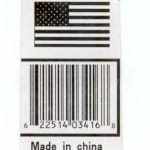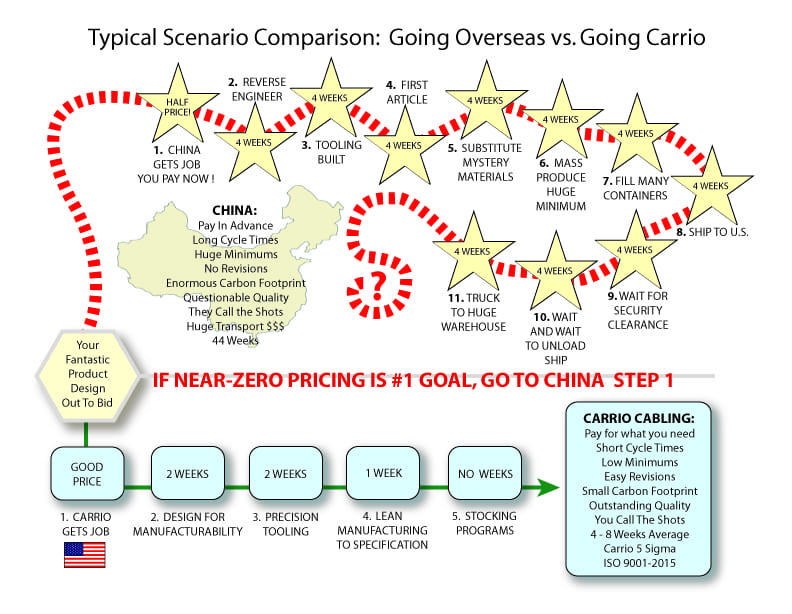Manufacturing Gone Wrong+ Made in China
Real-life examples …from real life
WARNING: COMEDY & THOUGHT-PROVOKING IDEAS AHEAD
If you can’t handle either, stop here.
It’s a sad state of affairs today. Not only is nearly every type of product imaginable made in China, but more and more Americans are on edge about the safety of buying China made. In fact, shouldn’t we be wondering about the sanity of this practice? Tainted toothpaste, defective tires, lead paint, mysterious ingredients, metal fragments in Valentine’s candy….are we crazy?
To compound the problem for Milfred and Betty Consumer, even if they decide to avoid anything China made, good luck. As Sara Bongiorni’s 2007 book A Year Without “Made in China” showed, this is a nearly impossible task.
Let’s be clear: The deplorable quality of so many Chinese goods is no reflection on the average Chinese worker, the Chinese people themselves, or products made in other countries. In fact, hey…maybe some day the vast majority of Chinese manufacturers will be following the same standards we follow in this country. When and if that happens, we American manufacturers may have something valid to worry about – and it may be time to look to them for tips.
In the meantime, we consumers have a quality problem on our hands. And we American manufacturers – those, at least, who haven’t given up and gone overseas with the rest of the gang – have a great market niche to fill.
Toilet seat covers, AKA “ass gaskets”
Some of the products we consumers use on a regular basis are fraught with manufacturing flaws, flaws I believe are amplified when American companies decide to send jobs and dollars to China. Case in point: the thin piece of paper available to us in toilet stalls across America to protect us from germs transmitted via the toilet seat. This ridiculously sheer piece of paper, AKA an ass gasket, is a great example of the potentially disastrous marriage of poor manufacturing and anything China made these days. There are problems with the design of the whole thing, whether made in the good ‘ole U.S. of A. or made in China, but I have to wonder what problems may befall us in the future just by trying to respond when nature calls.
Let’s look, first, at the design of the whole thing.
The gasket is essentially a rectangle, with a die-cut, open-ended oval shape…like the inside edge of a toilet seat. The sanitary center section is supposed to detach so you can use it. We’ll get to the problem of actually trying to use it in a minute, but the first problem the public restroom user faces is getting the so-called ask gasket out of the dispenser.
The average box holds 250-count, but the box is a third to 50 percent too small, which makes it bulge. The original gasket dispenser was a metal box with a lever on the right-hand side. I think the bulging box was intended to help dispense the product. But there’s a new design now – basically an open metal container, minus any dispensing lever, inside of which is a flat box bulging with gaskets. I suppose it would cost too much to make an elliptically shaped box that purposely bulges in the center.
The gaskets are so compressed in the flat box that it’s nearly impossible to just take one. When you reach in and try to remove one, you end up with a small scrap of paper between your fingers. You’ll probably go through at least two before you get a relatively intact one out. It takes a couple of tries to semi-master the act of pulling the gasket out of the box because it is destroyed in the removal process.
Let’s say you make it past getting the gasket out of the container – 1 or 2 destroyed versions lay at your feet – and you finally have one that’s not torn… too much. Your next task is to tear away the sanitary center section, which is largely cut away, but held together at three or four points.
For reasons unknown, ass gasket manufacturers have decided to make these reinforced points very long and place them along the widest part of the oval center and thus the least amount of paper between the center and the outer edge of the gasket. So if you try to tear the sanitary center out, it tears right through the side of the gasket. The result? A third or fourth tattered gasket now lays on the floor with the other two.
Why not make each attached point very, very small — say .003 – so it can be very easily torn? But, instead, each point is about an inch long. You practically need a pair of scissors to cut it. So there you are, while trying to get your business done, trying to tear along the line that will supposedly swing the center flap down and away. But instead, the center flap only partially tears or tears half of the gasket, and you are left with pieces of torn paper in your hand. I believe this is a way to sell more gaskets.
Let’s say you have succeeded in tearing away some part of the center section. Now you attempt to set the whole thing in its appropriate location. But the sanitary, floppy center – we’ll call it the tongue, if you will – touches the water in the tank. The tongue capillary attracts and the gasket miraculously moves forward and goes right into the toilet before you’ve actually used it. And now you have to repeat the process.
Not long ago, I visited the restroom of a local coffee shop to check out the latest version of the ass gasket. I found the problems highlighted here, but I also discovered, not surprisingly, that they are now made in China. What got my blood especially boiling was the picture of an American flag above the UPC scannable bar code and, underneath that, the words “Made in China.” Of course, the American flag is the only thing visible when the dispensing box is inside the metal container. I could only see the words “Made in China” when I pulled the box out.
 My blood pressure was rising at this point, but I was also worried. What are these things made of now that they are made in China? Are they made of grade A, sanitized, 100% wood pulp? Or are they perhaps made of rice pulp?
My blood pressure was rising at this point, but I was also worried. What are these things made of now that they are made in China? Are they made of grade A, sanitized, 100% wood pulp? Or are they perhaps made of rice pulp?
After all, that’s how Chinese manufacturers make their packing boxes, an approach that in and of itself isn’t all bad. But I won’t be surprised to learn some day that there’s some sort of terrible flesh-eating virus inside the pulp because the Chinese manufacturer decided to skip the sanitizing step to kill any possible nasties. Maybe it will be like the Chinese company that simply decided one day to stop adding gum strips to automobile tires…you know, the little pieces of rubber that actually hold the tire treads together.
Perhaps we’ll find out one day that every time we sit down on one of these presumably sanitary pieces of paper, a “C” is etched in our posterior from some unknown something. If I ever use one of these again, I’ll think I’m being protected, but I’ll be wondering whether every time I sit down I’m taking a shot of formaldehyde, which American inspectors have been finding in excessive levels in imported Chinese plywood.
So many business owners are criticized, wholesale, for their lack of regard for the environment. Carrio Cabling takes pride in doing everything we can to reduce consumption, reuse materials, and recycle. But in this case, I’d prefer to cut down a gigantic 250- to 500-year-old redwood in the Pacific Northwest and have a great American company make it – design flaws and all. At least I’d trust that it is free of cooties, like it’s supposed to be. Besides, when I flush, I want to flush with pride.
You know, toilet seat cover manufacturers have a great market. They can move 20-30-40 percent more product because a good 20-30 percent cannot be removed from the dispensing unit…and another 20-30 percent are destroyed in the process of trying to tear out the sanitary center section. The end user, the butt of all jokes, is the one who’s frustrated. Even the purchaser of these products may be in the dark. After all, how many ass gasket users report back to the company about the number torn, destroyed, or inadvertently sucked into the toilet before use?
It’s the distributors who are making money by moving 20-30 percent more ass gaskets because they’re of inferior quality. These are the same companies who, amazingly, print a black American flag above the words “Made in China.”
The gasket dilemma is an arena that environmentalists ought to be focused on. Imagine if 30 percent less ass gaskets were used in the United States, how much paper would not be wasted. Imagine if the user could actually use the very first one, the first time, as God intended. Think about that.


